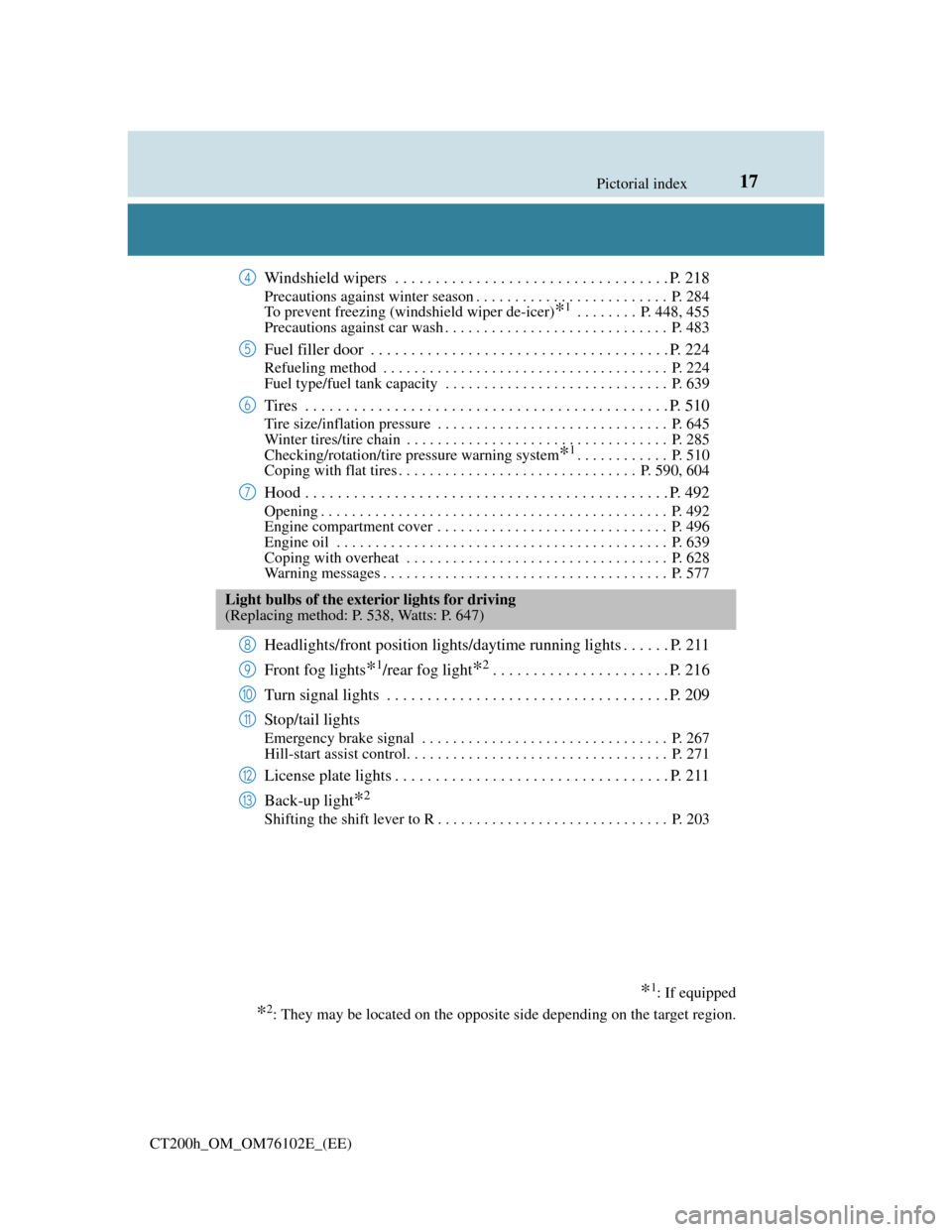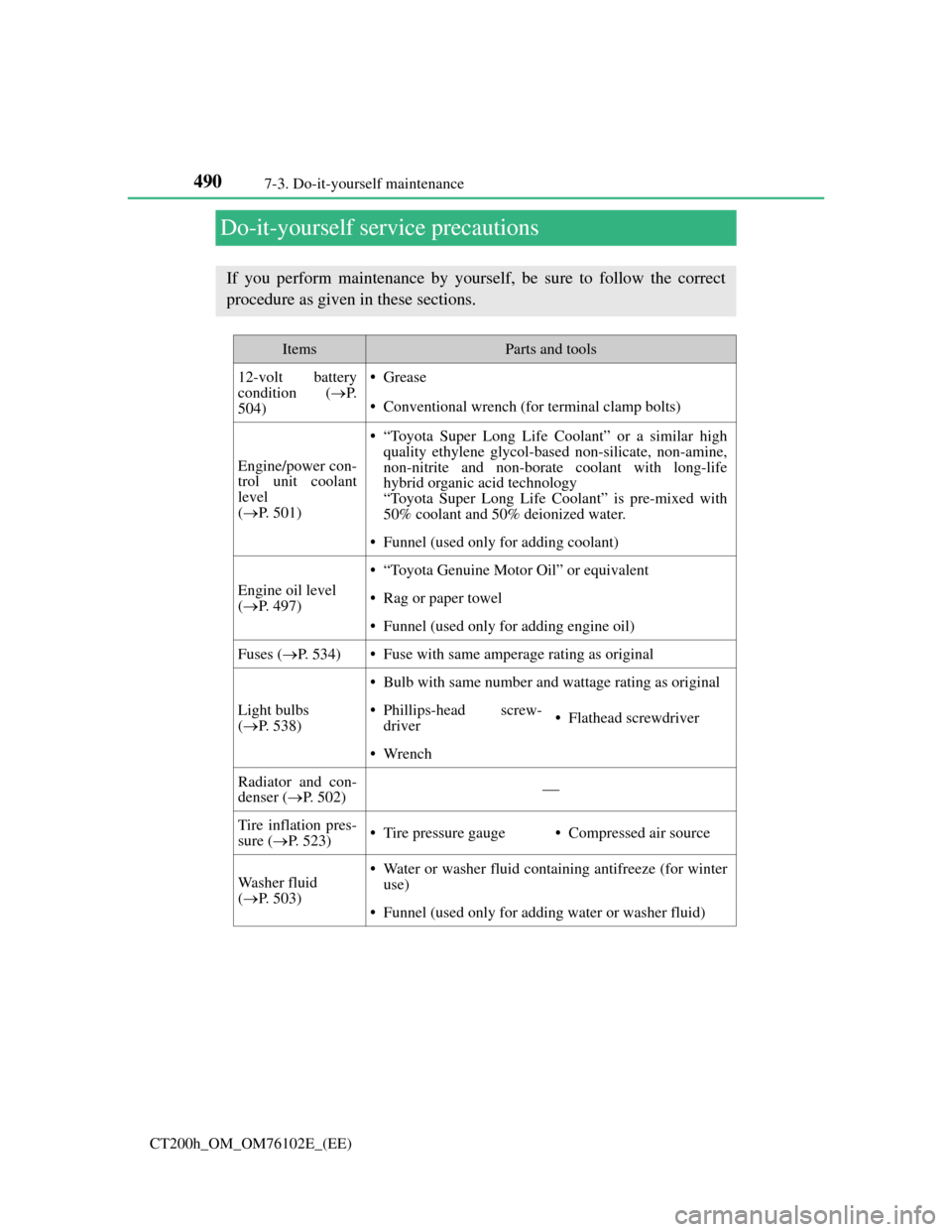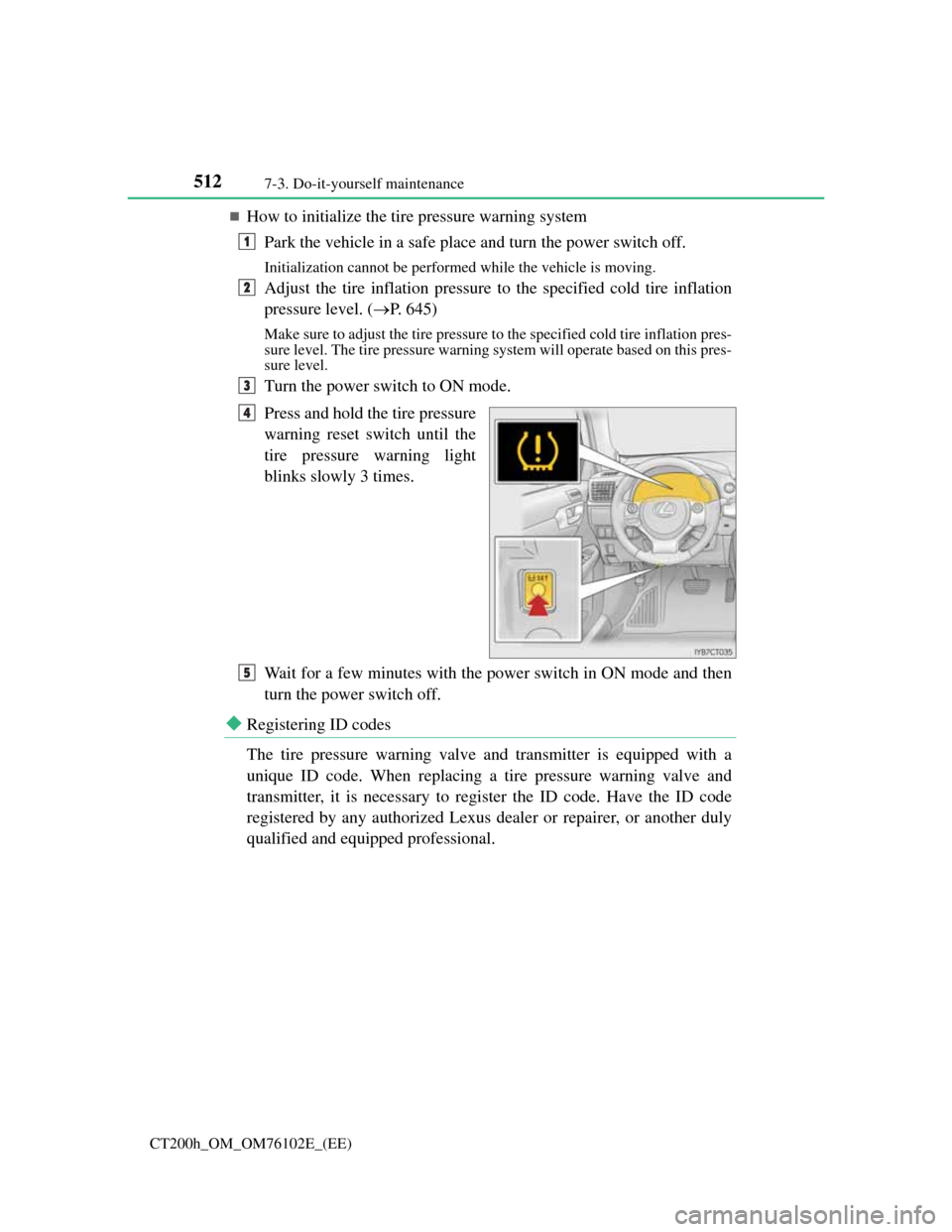inflation pressure Lexus CT200h 2013 Owner's Manual (in English)
[x] Cancel search | Manufacturer: LEXUS, Model Year: 2013, Model line: CT200h, Model: Lexus CT200h 2013Pages: 688
Page 7 of 688

7
1
8 7
6
5
4
3
2
CT200h_OM_OM76102E_(EE)
9
6-4. Other interior features
Other interior features ....... 473
• Sun visors...................... 473
• Vanity mirrors ............... 473
• Clock ............................. 474
• Power outlet .................. 475
• Assist grips.................... 477
7-1. Maintenance and care
Cleaning and protecting the
vehicle exterior.................480
Cleaning and protecting the
vehicle interior.................484
7-2. Maintenance
Maintenance require-
ments...............................4877-3. Do-it-yourself maintenance
Do-it-yourself service precau-
tions..................................490
Hood .................................. 492
Positioning a floor jack ..... 494
Engine compartment ......... 495
12-volt battery ................... 504
Tires................................... 510
Tire inflation pressure ....... 523
Wheels............................... 525
Air conditioning filter ....... 527
Electronic key battery ....... 530
Checking and replacing
fuses.................................534
Light bulbs ........................ 538
8-1. Essential information
Emergency flashers ........... 560
If your vehicle has to be stopped
in an emergency...............561
7Maintenance and care
8When trouble arises
Page 17 of 688

17Pictorial index
CT200h_OM_OM76102E_(EE)
Windshield wipers . . . . . . . . . . . . . . . . . . . . . . . . . . . . . . . . . . P. 218
Precautions against winter season . . . . . . . . . . . . . . . . . . . . . . . . . P. 284
To prevent freezing (windshield wiper de-icer)
*1 . . . . . . . . P. 448, 455
Precautions against car wash . . . . . . . . . . . . . . . . . . . . . . . . . . . . . P. 483
Fuel filler door . . . . . . . . . . . . . . . . . . . . . . . . . . . . . . . . . . . . . P. 224
Refueling method . . . . . . . . . . . . . . . . . . . . . . . . . . . . . . . . . . . . . P. 224
Fuel type/fuel tank capacity . . . . . . . . . . . . . . . . . . . . . . . . . . . . . P. 639
Tires . . . . . . . . . . . . . . . . . . . . . . . . . . . . . . . . . . . . . . . . . . . . . P. 510
Tire size/inflation pressure . . . . . . . . . . . . . . . . . . . . . . . . . . . . . . P. 645
Winter tires/tire chain . . . . . . . . . . . . . . . . . . . . . . . . . . . . . . . . . . P. 285
Checking/rotation/tire pressure warning system
*1. . . . . . . . . . . . P. 510
Coping with flat tires . . . . . . . . . . . . . . . . . . . . . . . . . . . . . . . P. 590, 604
Hood . . . . . . . . . . . . . . . . . . . . . . . . . . . . . . . . . . . . . . . . . . . . . P. 492
Opening . . . . . . . . . . . . . . . . . . . . . . . . . . . . . . . . . . . . . . . . . . . . . P. 492
Engine compartment cover . . . . . . . . . . . . . . . . . . . . . . . . . . . . . . P. 496
Engine oil . . . . . . . . . . . . . . . . . . . . . . . . . . . . . . . . . . . . . . . . . . . P. 639
Coping with overheat . . . . . . . . . . . . . . . . . . . . . . . . . . . . . . . . . . P. 628
Warning messages . . . . . . . . . . . . . . . . . . . . . . . . . . . . . . . . . . . . . P. 577
Headlights/front position lights/daytime running lights . . . . . . P. 211
Front fog lights
*1/rear fog light*2. . . . . . . . . . . . . . . . . . . . . . P. 216
Turn signal lights . . . . . . . . . . . . . . . . . . . . . . . . . . . . . . . . . . . P. 209
Stop/tail lights
Emergency brake signal . . . . . . . . . . . . . . . . . . . . . . . . . . . . . . . . P. 267
Hill-start assist control. . . . . . . . . . . . . . . . . . . . . . . . . . . . . . . . . . P. 271
License plate lights . . . . . . . . . . . . . . . . . . . . . . . . . . . . . . . . . . P. 211
Back-up light
*2
Shifting the shift lever to R . . . . . . . . . . . . . . . . . . . . . . . . . . . . . . P. 203
4
5
6
7
Light bulbs of the exterior lights for driving
(Replacing method: P. 538, Watts: P. 647)
*1: If equipped
*2: They may be located on the opposite side depending on the target region.
8
9
10
11
12
13
Page 272 of 688

2724-5. Using the driving support systems
CT200h_OM_OM76102E_(EE)
WA R N I N G
The ABS does not operate effectively when
The limits of tire gripping performance have been exceeded (such as exces-
sively worn tires on a snow covered road).
The vehicle hydroplanes while driving at high speed on wet or slick road.
Stopping distance when the ABS is operating may exceed that of normal condi-
tions
The ABS is not designed to shorten the vehicle’s stopping distance. Always
maintain a safe distance from the vehicle in front of you, especially in the fol-
lowing situations:
When driving on dirt, gravel or snow-covered roads
When driving with tire chains
When driving over bumps in the road
When driving over roads with potholes or uneven surfaces
TRC may not operate effectively when
Directional control and power may not be achievable while driving on slippery
road surfaces, even if the TRC system is operating.
Drive the vehicle carefully in conditions where stability and power may be lost.
When the VSC is activated
The slip indicator light flashes. Always drive carefully. Reckless driving may
cause an accident. Exercise particular care when the indicator light flashes.
When the TRC system is turned off
Be especially careful and drive at a speed appropriate to the road conditions. As
these are the system to help ensure vehicle stability and driving force, do not
turn the TRC system off unless necessary.
Replacing tires
Make sure that all tires are of the specified size and of the same brand, tread
pattern and total load capacity. In addition, make sure that the tires are inflated
to the recommended tire inflation pressure level.
The ABS, VSC and TRC systems will not function correctly if different tires
are installed on the vehicle.
Contact any authorized Lexus dealer or repairer, or another duly qualified and
equipped professional for further information when replacing tires or wheels.
Handling of tires and the suspension
Using tires with any kind of problem or modifying the suspension will affect
the driving assist systems, and may cause a system to malfunction.
Page 284 of 688

2824-6. Driving tips
CT200h_OM_OM76102E_(EE)
Delays
Repeated acceleration and deceleration, as well as long waits at traffic
lights, will lead to bad fuel economy. Check traffic reports before leav-
ing and avoid delays as much as possible. When driving in a traffic
jam, gently release the brake pedal to allow the vehicle to move for-
ward slightly while avoiding overuse of the accelerator pedal. Doing so
can help control excessive gasoline consumption.
Highway driving
Control and maintain the vehicle at a constant speed. Before stopping
at a toll booth or similar, allow plenty of time to release the accelerator
and gently apply the brakes. A greater amount of electrical energy can
be regenerated when slowing down.
Air conditioning
Use the air conditioning only when necessary. Doing so can help
reduce excessive gasoline consumption.
In summer: When the ambient temperature is high, use the recirculated
air mode. Doing so will help to reduce the burden on the air condition-
ing system and reduce fuel consumption as well.
In winter: Because the gasoline engine will not automatically cut out
until it and the interior of the vehicle are warm, it will consume fuel.
Fuel consumption can be improved by avoiding overuse of the heater.
Checking tire inflation pressure
Make sure to check the tire inflation pressure frequently. Improper tire
inflation pressure can cause poor fuel economy.
Also, as snow tires can cause large amounts of friction, their use on dry
roads can lead to poor fuel economy. Use tires that are appropriate for
the season.
Page 483 of 688

479
7Maintenance and care
CT200h_OM_OM76102E_(EE)
7-1. Maintenance and care
Cleaning and protecting the
vehicle exterior ............... 480
Cleaning and protecting the
vehicle interior ................ 484
7-2. Maintenance
Maintenance
requirements ................... 487
7-3. Do-it-yourself maintenance
Do-it-yourself service
precautions...................... 490
Hood ................................. 492
Positioning a floor jack ..... 494
Engine compartment ......... 495
12-volt battery................... 504
Tires .................................. 510
Tire inflation pressure ....... 523
Wheels .............................. 525
Air conditioning filter ....... 527
Electronic key battery ....... 530
Checking and replacing
fuses ................................ 534
Light bulbs ........................ 538
Page 494 of 688

4907-3. Do-it-yourself maintenance
CT200h_OM_OM76102E_(EE)
Do-it-yourself service precautions
If you perform maintenance by yourself, be sure to follow the correct
procedure as given in these sections.
ItemsParts and tools
12-volt battery
condition (P.
504)•Grease
• Conventional wrench (for terminal clamp bolts)
Engine/power con-
trol unit coolant
level
(P. 501)• “Toyota Super Long Life Coolant” or a similar high
quality ethylene glycol-based non-silicate, non-amine,
non-nitrite and non-borate coolant with long-life
hybrid organic acid technology
“Toyota Super Long Life Coolant” is pre-mixed with
50% coolant and 50% deionized water.
• Funnel (used only for adding coolant)
Engine oil level
(P. 497)
• “Toyota Genuine Motor Oil” or equivalent
• Rag or paper towel
• Funnel (used only for adding engine oil)
Fuses (P. 534)• Fuse with same amperage rating as original
Light bulbs
(P. 538)
• Bulb with same number and wattage rating as original
• Phillips-head screw-
driver• Flathead screwdriver
• Wrench
Radiator and con-
denser (P. 502)
Tire inflation pres-
sure (P. 523)• Tire pressure gauge• Compressed air source
Washer fluid
(P. 503)• Water or washer fluid containing antifreeze (for winter
use)
• Funnel (used only for adding water or washer fluid)
Page 515 of 688

5117-3. Do-it-yourself maintenance
CT200h_OM_OM76102E_(EE)
7
Maintenance and care
Your vehicle is equipped with a tire pressure warning system that uses tire
pressure warning valves and transmitters to detect low tire inflation pres-
sure before serious problems arise.
If the tire pressure drops below a predetermined level, the driver is
warned by a warning light. (P. 571)
Installing tire pressure warning valves and transmitters
When replacing tires or wheels, tire pressure warning valves and trans-
mitters must also be installed.
When new tire pressure warning valves and transmitters are installed,
new ID codes must be registered in the tire pressure warning computer
and the tire pressure warning system must be initialized. Have tire
pressure warning valve and transmitter ID codes registered by any
authorized Lexus dealer or repairer, or another duly qualified and
equipped professional. (P. 512)
Initializing the tire pressure warning system
The tire pressure warning system must be initialized in the following
circumstances:
Vehicles with 17 inch tires: When rotating front and rear tires which
have different tire inflation pressures
When the tire inflation pressure is changed such as when changing
traveling speed or load weight.
When changing the tire size
When the tire pressure warning system is initialized, the current tire
inflation pressure is set as the benchmark pressure.
Tire pressure warning system (if equipped)
Page 516 of 688

5127-3. Do-it-yourself maintenance
CT200h_OM_OM76102E_(EE)
How to initialize the tire pressure warning system
Park the vehicle in a safe place and turn the power switch off.
Initialization cannot be performed while the vehicle is moving.
Adjust the tire inflation pressure to the specified cold tire inflation
pressure level. (P. 645)
Make sure to adjust the tire pressure to the specified cold tire inflation pres-
sure level. The tire pressure warning system will operate based on this pres-
sure level.
Turn the power switch to ON mode.
Press and hold the tire pressure
warning reset switch until the
tire pressure warning light
blinks slowly 3 times.
Wait for a few minutes with the power switch in ON mode and then
turn the power switch off.
Registering ID codes
The tire pressure warning valve and transmitter is equipped with a
unique ID code. When replacing a tire pressure warning valve and
transmitter, it is necessary to register the ID code. Have the ID code
registered by any authorized Lexus dealer or repairer, or another duly
qualified and equipped professional.
1
2
3
4
5
Page 517 of 688

5137-3. Do-it-yourself maintenance
CT200h_OM_OM76102E_(EE)
7
Maintenance and care
When to replace your vehicle’s tires
Tires should be replaced if:
You have tire damage such as cuts, splits, cracks deep enough to expose the fab-
ric, and bulges indicating internal damage.
A tire goes flat repeatedly or cannot be properly repaired due to the size or loca-
tion of a cut or other damage.
If you are not sure, consult with any authorized Lexus dealer or repairer, or
another duly qualified and equipped professional.
Replacing tires and wheels
If the ID code of the tire pressure warning valve and transmitter is not registered,
the tire pressure warning system will not work properly. After driving for about
10 minutes, the tire pressure warning light blinks for 1 minute and stays on to
indicate a system malfunction.
Tire life
Any tire over 6 years old must be checked by a qualified technician even if it has
seldom or never been used or damage is not obvious.
Routine tire inflation pressure checks
The tire pressure warning system does not replace routine tire inflation pressure
checks. Make sure to check tire inflation pressure as part of your routine of daily
vehicle checks.
Low profile tires (vehicles with 17 inch tires)
Generally, low profile tires will wear more rapidly and tire grip performance will
be reduced on snowy and/or icy roads when compared to standard tires. Be sure
to use snow tires or tire chains on snowy and/or icy roads and drive carefully at a
speed appropriate for road and weather conditions.
If the tread on snow tires wears down below 4 mm (0.16 in.)
The effectiveness of the tires as snow tires is lost.
Page 518 of 688

5147-3. Do-it-yourself maintenance
CT200h_OM_OM76102E_(EE)
Situations in which the tire pressure warning system may not operate properly
In the following cases, the tire pressure warning system may not operate prop-
erly.
• If non-genuine Lexus wheels are used.
• A tire has been replaced with a tire that is not an OE (Original Equipment)
tire.
• A tire has been replaced with a tire that is not of the specified size.
• Tire chains etc. are equipped.
• Lock nuts are equipped.
• An auxiliary-supported run-flat tire is equipped.
• If a window tint that affects the radio wave signals is installed.
• If there is a lot of snow or ice on the vehicle, particularly around the wheels
or wheel housings.
• If the tire inflation pressure is extremely higher than the specified level.
• If wheel without the tire pressure warning valve and transmitter is used.
• If the ID code on the tire pressure warning valves and transmitters is not reg-
istered in the tire pressure warning computer.
Performance may be affected in the following situations.
• Near a TV tower, electric power plant, gas station, radio station, large dis-
play, airport or other facility that generates strong radio waves or electrical
noise
• When carrying a portable radio, cellular phone, cordless phone or other
wireless communication device
When the vehicle is parked, the time taken for the warning to start or go off
could be extended.
When tire inflation pressure declines rapidly for example when a tire has burst,
the warning may not function.